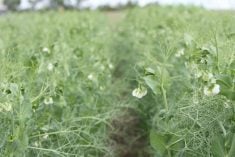Pea prices will remain flat for the remainder of the 2010-11 marketing year and rise in 2011-12, according to a market analyst.
Chuck Penner, founder of LeftField Commodity Research, told producers attending a Pulse Days pea market meeting held during Crop Production Week in Saskatoon that they can expect yellow pea prices to stay in the $6.25 to $6.75 per bushel range for the remainder of this year and then jump to an average of $7 to $8 the following crop year.
The green pea premium could widen to $1.50 per bu. this marketing year because they have worse quality issues than yellows.
Read Also

Fendt takes a combine on the road in the U.S.
Putting an Ideal combine in fields across different regions has given the brand a chance to prove that the combine is capable of performing well in a variety of conditions.
Also, the export pace for greens is expected to be better than yellows for the remainder of 2010-11. Penner expects the premium to fall back to $1 in the new crop year.
His bullish price outlook stems from the astonishing pace of Canadian yellow pea exports in 2010-11, which should lead to tight supplies.
Exporters had shipped 922,000 tonnes of bulk peas by the end of November, up 73 percent from the same time a year ago despite having a smaller crop to move.
“It has absolutely blown my expectations away,” said Penner.
He is forecasting fewer than 300,000 tonnes of carryout, down from 800,000 tonnes in 2009-10.
One significant bearish factor is the potential for India to harvest what Penner believes could be an 18 million tonne crop of pulses, up from the average of 14.5 million tonnes.
The crop is a long way from the bin, but chickpea futures markets in India indicate traders there expect a bigger harvest.
“It’s a bit of a heads up, a bit of a warning signal,” said Penner.
However, he expects a bigger Indian winter crop won’t devastate Canadian yellow pea prices because it will hit the market in February and March, just as Canadian supplies are dwindling.
If there is any softness in the Indian market, peas will go instead to feed markets in Europe where feed pea prices have risen by $45 to $50 US per tonne since the end of November.
That market should provide a good floor for pea prices.
Shyam Venkatesan, sales manager for the Indian subcontinent and United States for Walker Seeds Ltd., wouldn’t forecast an average price for 2011-12, but he agreed with Penner that it would be higher than 2010-11.
He surprised growers with his comment on the reputation of Canadian peas versus their American counterparts.
“Certain markets definitely prefer U.S. peas, prominently India. They consider them more smooth and round than Canadian peas. Also, the size of the peas is usually preferred.”
Indonesia and the Philippines also prefer U.S. peas for their snack food market.
U.S. varieties are commanding a $20 per tonne premium in bulk markets and a $100 per tonne premium to Canada’s bulk green peas in niche markets.
“We need to develop similar varieties,” said Venkatesan.
Lara Dutton, trader with Western Grain Ltd., said she was in the “sky is falling” camp for prices because of forecasts calling for another wet growing season in Canada, which peas tend to like.
She encouraged growers to consider planting a small amount of niche crops such as small yellow and green peas, maple peas, Austrian winter peas and marrowfat peas.
“This is a 300,000 tonne market that comes to us with a premium and we needtotakeadvantageofit,” saidDutton.
Panel moderator Kevin Hursh questioned whether the premium was worth the hassle of trying to grow and market niche peas.
Dutton said Western Grain was contracting Espace peas for $9.50 per bu. at one point last year when green peas were selling for $7.50 to $8.















